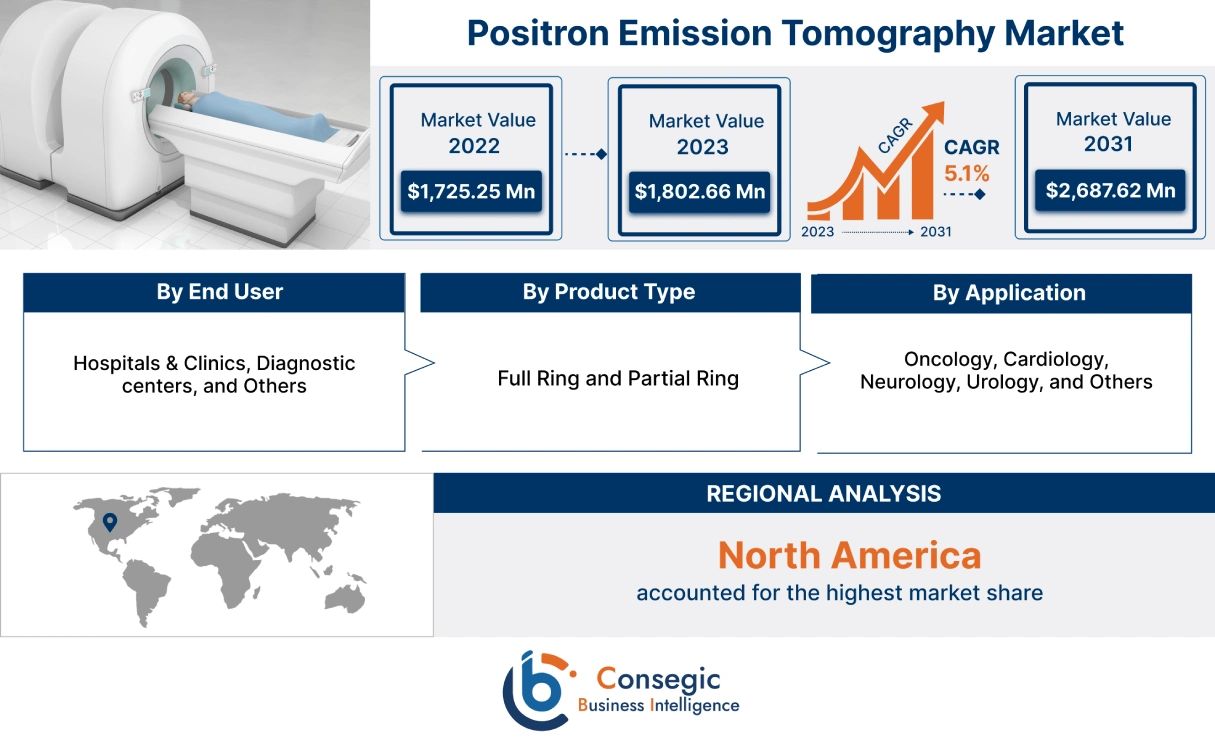Positron Emission Tomography Market Size :
Consegic Business Intelligence analyzes that the positron emission tomography market size is growing with a CAGR of 5.1% during the forecast period (2023-2031), and the market is projected to be valued at USD 2,687.62 million by 2031 and USD 1,802.66 million in 2023 from USD 1,725.25 million in 2022.
Positron Emission Tomography Market Scope & Overview:
Positron emission tomography (PET) is a type of nuclear medicine imaging that uses small amounts of radioactive materials called radiotracers to visualize and measure changes in metabolic processes and other physiological activities namely blood flow, regional chemical composition, and absorption. As per the analysis, PET is a common imaging and medical technique used in nuclear medicine. They are used to diagnose and evaluate a variety of conditions such as cancer, heart disease, brain disorders, infections, inflammatory diseases, psychiatric diseases, and others. PET scans can also be used to monitor the response to treatment and to conduct research on new drugs and therapies.
Positron Emission Tomography Market Insights :
Positron Emission Tomography Market Dynamics - (DRO) :
Key Drivers :
Increasing prevalence of cancer globally is driving the market growth
Cancer is the most common application of PET scans. PET scans are very effective at detecting cancer cells, even before they are large enough to be seen on other imaging tests. This makes PET scans ideal for early cancer detection. Also, the scans can be used to stage cancer, which helps doctors to determine the extent of the disease and to develop a treatment plan. Most importantly, the scans can be used to monitor the response to cancer treatment, which helps doctors to assess the effectiveness of the treatment and to make necessary adjustments. Thus, based on the analysis, the increasing prevalence of cancer is a major driver of the trends of the PET market. For instance, according to a report by the World Health Organization (WHO) in 2021, an estimated 19.3 million new cancer cases were diagnosed worldwide in 2020. The WHO also estimates that the global cancer burden will continue to grow, with an estimated 28.88 million new cancer cases diagnosed worldwide in 2040. Hence, rising cases of cancer globally is driving the PET market expansion.
Rising awareness of PET scans is boosting the market expansion
Patients and physicians are becoming more aware of the benefits of PET scans, which is leading to increased trends for the procedure. PET scans are known to be very effective at detecting cancer cells early, staging cancer accurately, and monitoring the response to cancer treatment. Furthermore, the most important reason contributing to the growing awareness of PET scans is the growing availability of PET scanners. PET scanners are becoming very common in hospitals and imaging centers around the world. This makes PET scans more accessible to a wider range of patients. Overall, the increased awareness of PET scans is a major driver of the expansion of the PET market. As more patients and physicians are becoming aware of the benefits of PET scans, trends for the procedure is increasing significantly. Hence, due to the growing awareness of PET scans, the positron emission tomography market is witnessing significant expansion.
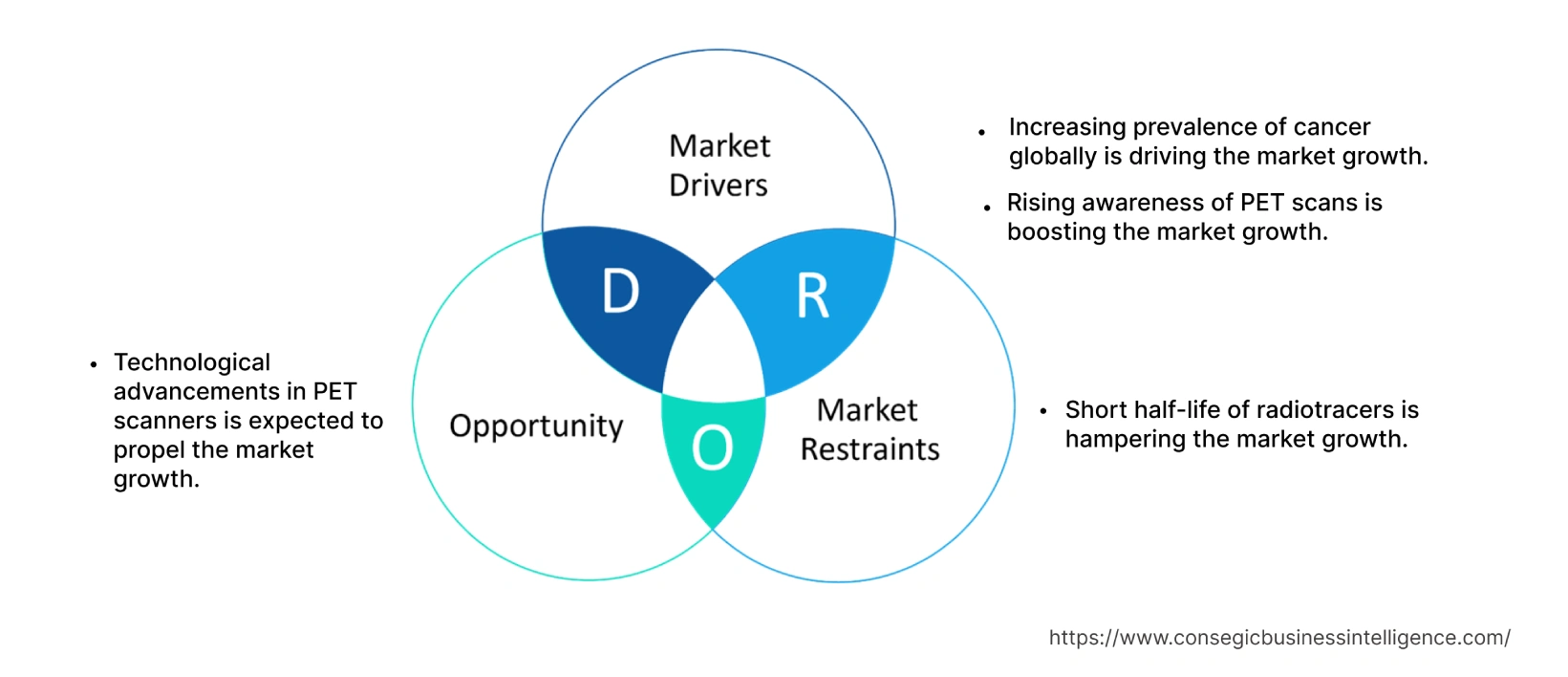
Key Restraints :
Short half-life of radiotracers is hampering the market expansion
Radiotracers have a short half-life, which means that they must be used quickly after they are produced. This can make it difficult to schedule PET scans and can lead to delays in diagnosis and treatment. Thus, it becomes a challenge for PET imaging as the radiotracers must be injected and imaged within a short period. As per the analysis, the short half-life of the radiotracers is leading to other problems as well such as logistic challenges, increased cost of the PET scanners, and others. Hence, owing to the aforementioned factors, the short half-life of radiotracers is hampering the market trends.
Future Opportunities :
Technological advancements in PET scanners is expected to propel the market expansion
There are different ongoing technological advancements in the PET market such as improved detector technology, development of new radiotracers, integration with other imaging technologies, and others, which is creating lucrative positron emission tomography market opportunities and trends New detector technologies are being developed that allow PET scanners to image at higher resolutions and with shorter scan times. As per the analysis, this is making PET scans more accurate and efficient. Also, PET scanners are being integrated with other imaging technologies, such as CT scanners and MRI scanners. This allows for more comprehensive and detailed imaging. These technological advancements are making PET scans more accurate, efficient, and accessible. Hence, technological advancements by the key players in the market are expected to drive the PET market further. For instance, in 2023, Siemens Healthineers developed a new PET scanner called the Biograph Vision.X PET/CT scanner. This scanner uses a new radiotracer called fluciclovine (Axumin) to image prostate cancer. Axumin is more specific to prostate cancer than other radiotracers, which makes PET scans for prostate cancer more sensitive and specific. Thus, due to various technological innovations, the PET market is expected to create opportunities and positron emission tomography market trends and opportunities further in the forecast period.
Positron Emission Tomography Market Report Insights :
| Report Attributes | Report Details |
| Study Timeline | 2017-2031 |
| Market Size in 2031 | USD 2,687.62 Million |
| CAGR (2023-2031) | 5.1% |
| By Product Type | Full Ring and Partial Ring |
| By Application | Oncology, Cardiology, Neurology, Urology, and Others |
| By End User | Hospitals & Clinics, Diagnostic centers, and Others |
| By Region | North America, Europe, Asia-Pacific, Latin America, and Middle East & Africa |
| Key Players | GE Healthcare, Siemens Healthineers, Philips Healthcare, Canon Medical Systems, Hitachi Healthcare, Toshiba Medical Systems, Positron Corporation, Mediso Ltd., PerkinElmer, Inc., and Yangzhou Kindsway Biotech Co. Ltd |
| Geographies Covered | |
| North America | U.S. Canada Mexico |
| Europe | U.K. Germany France Spain Italy Russia Benelux Rest of Europe |
| APAC | China South Korea Japan India Australia ASEAN Rest of Asia-Pacific |
| Middle East and Africa | GCC Turkey South Africa Rest of MEA |
| LATAM | Brazil Argentina Chile Rest of LATAM |
| Report Coverage | Revenue Forecast, Competitive Landscape, Growth Factors, Restraint or Challenges, Opportunities, Environment & Regulatory Landscape, PESTLE Analysis, PORTER Analysis, Key Technology Landscape, Value Chain Analysis, Cost Analysis, and Regional Trends & Forecast |
Positron Emission Tomography Market Segmental Analysis :
By Product Type :
The product type segment is categorized into full ring and partial ring. In 2022, the full ring segment accounted for the highest positron emission tomography market share due to the superior image quality offered by full ring PET scanners. Full rings have a ring of detectors that surrounds the patient, which allows for the most accurate and detailed images. Full ring PET scanners are typically more expensive than partial ring PET scanners, but they offer the best image quality. Thus, due to the aforementioned factors, the full ring segment is experiencing significant positron emission tomography market growth.
Moreover, the partial ring segment is expected to grow at the fastest CAGR over the forecast period in the positron emission tomography market. Based on the analysis, increasing demand for PET imaging in developing countries, lower cost of partial ring PET scanners, and technological advancements in partial ring PET imaging are driving the trends of partial ring segment in the positron emission tomography market. Hence, due to the aforementioned factors, the partial ring PET scanner is growing at a positive rate.
By Application :
The application segment is categorized into oncology, cardiology, neurology, urology, and others. In 2022, the oncology segment accounted for the highest market share in the positron emission tomography market. PET is used in oncology for wide applications such as diagnosis and staging of cancer, monitoring the response of the cancer to treatment, monitoring for cancer recurrence after treatment, and others. Furthermore, the increasing prevalence of cancer is driving the expansion of the usage of PET in oncology. Hence, based on the analysis, due to the demand for PET in the aforementioned applications, the oncology segment is experiencing significant growth in the positron emission tomography market demand and trends.
Moreover, the neurology segment is expected to grow at the fastest CAGR over the forecast period in the positron emission tomography market. PET imaging can be used to diagnose neurodegenerative diseases, such as Alzheimer's disease and Parkinson's disease, assess cognitive function in patients with neurological disorders, and assess cognitive function in patients with neurological disorders. Thus, due to the wide usage of the product in the segment, neurology is expected to grow significantly in the forecast period.
By End User :
The end user segment is categorized into hospitals & clinics, diagnostic centers, and others. In 2022, the hospitals & clinics segment accounted for the highest market share of 48.90% and is expected to grow at the fastest CAGR over the forecast period in the positron emission tomography market. Hospitals and clinics are the primary end users of PET imaging. They use PET imaging for a wide range of purposes such as diagnosing cancer, assessing heart function, diagnosing and monitoring neurological disorders, and others. Furthermore, PET imaging is a valuable tool for hospitals and clinics as it provides detailed images of the body's metabolism, which can help healthcare professionals to diagnose and monitor a variety of diseases. Moreover, the increasing hospitals and clinics is driving more development for PET. For instance, according to a recent study by Invest India in 2023, the hospital industry in India, accounted for 80% of the total healthcare market and is witnessing a huge investor demand from both global as well as domestic investors. Hence, hospitals & clinics segment is witnessing significant growth in the positron emission tomography market.
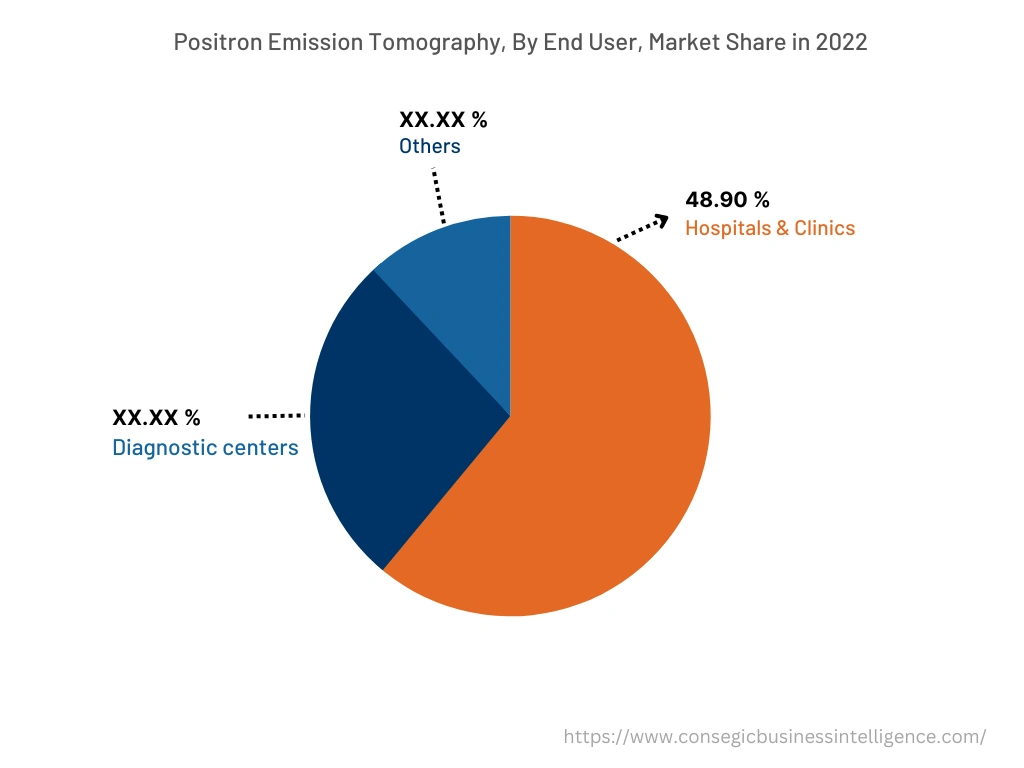
By Region :
The regional segment includes North America, Europe, Asia Pacific, the Middle East and Africa, and Latin America.
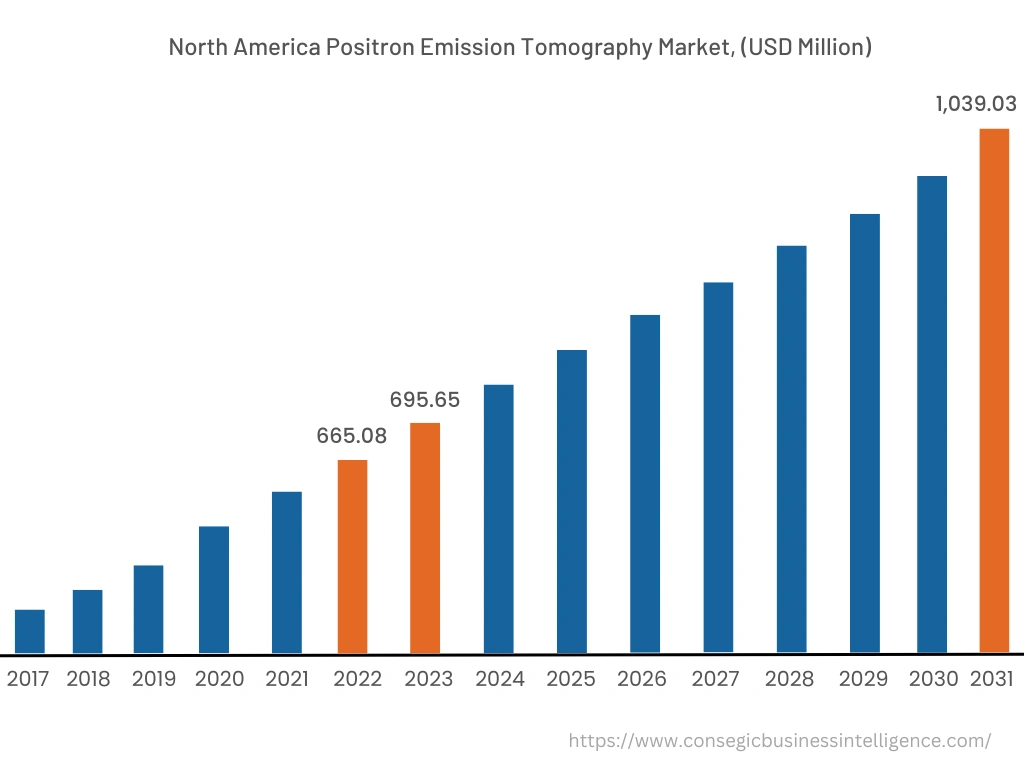
In 2022, North America accounted for the highest market share at 38.55%, valued at USD 665.08 million in 2022 and USD 695.65 million in 2023, it is expected to reach USD 1,039.03 million in 2031. In North America, the U.S. accounted for the highest market share of 64.10% during the base year 2022. Based on the positron emission tomography market analysis, this is due to the high prevalence of chronic diseases in North America and the early adoption of new medical technologies in the region. Chronic diseases, such as cancer, heart disease, and neurological disorders, are becoming more common in North America. PET imaging is a valuable tool for diagnosing and monitoring these diseases. Furthermore, various players in the region are investing in the development of new PET scanners and radiotracers. For instance, in 2023, Philips Healthcare developed a new PET scanner called the Vereos PET/CT scanner. This scanner can be integrated with both CT scanners and MRI scanners. This allows for more comprehensive and detailed imaging of the patient. Thus, due to the aforementioned factors, North America is witnessing significant growth in the positron emission tomography market.
Moreover, Asia Pacific is expected to witness significant growth over the forecast period, growing at a CAGR of 5.7% during 2023-2031. The geriatric population is growing largely in the region. This population is more likely to develop chronic diseases, which is driving further demand for PET imaging. Also, favorable government policies and initiatives, such as providing subsidies for the purchase of PET scanners and training programs for PET technicians are supporting the growth of the PET market. Also, patients and physicians in the region are becoming more aware of the benefits of PET imaging. This is leading to increased demand for the procedure in Asia Pacific. Hence, due to the aforementioned factors, Asia Pacific is growing at a positive rate in the market.
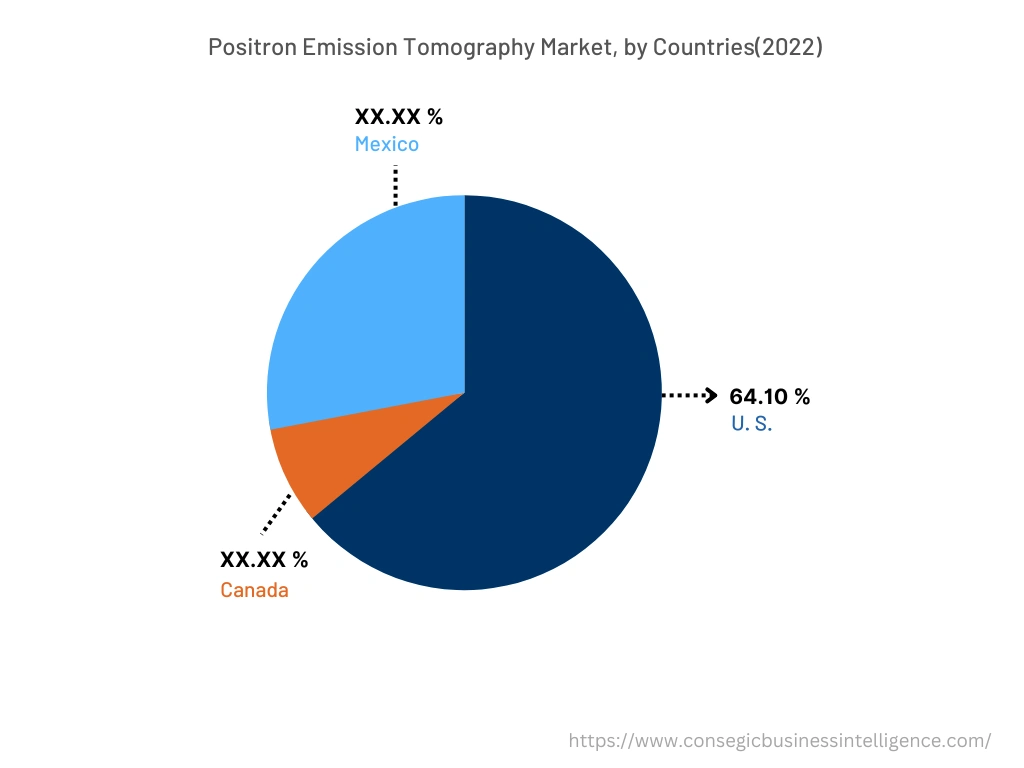
Top Key Players & Market Share Insights:
The global Positron Emission Tomography market is highly competitive, with several large players and numerous small and medium-sized enterprises. These companies have strong research and development capabilities and a strong presence in the market through their extensive product portfolios and distribution networks. The market is characterized by intense competition, with companies focusing on expanding their product offerings and increasing their market share through mergers, acquisitions, and partnerships. The key players in the global positron emission tomography industry include-
- Whirlpool Corporation
- Samsung Electronics Co. Ltd.
- Bosch-Siemens Hausgeräte
- Electrolux AB
- Voltas Limited
- Haier Inc.
- Bajaj Electricals Ltd.
- IFB Appliances
- Panasonic Holdings Corporation
- LG Electronics
Recent Industry Developments :
- In October 2022, GE Healthcare launched the Omni Legend, an all-digital PET/CT platform, at the European Association of Nuclear Medicine (EANM) Annual Meeting. The Omni Legend includes a new digital BGO detector material with a tiny crystal size. This material provides more than twice the sensitivity of previous digital scanners.
- In June 2023, Siemens Healthineers launched a new PET/CT scanner, named Biograph Vision.X at the 2023 Society of Nuclear Medicine and Molecular Imaging (SNMMI) Annual Meeting in Chicago. The scanner has an industry-best time of flight (TOF) of 178 picoseconds.
Key Questions Answered in the Report
What was the market size of the positron emission tomography industry in 2022? +
In 2022, the market size of positron emission tomography was USD 1,725.25 million.
What will be the potential market valuation for the positron emission tomography industry by 2031? +
In 2031, the market size of positron emission tomography will be expected to reach USD 2,687.62 million.
What are the key factors driving the growth of the positron emission tomography market? +
Increasing prevalence of cancer is fueling market growth at the global level.
What is the dominating segment in the positron emission tomography market by end user? +
In 2022, the hospitals & clinics segment accounted for the highest market share of 48.90% in the overall positron emission tomography market.
Based on current market trends and future predictions, which geographical region is the dominating region in the positron emission tomography market? +
North America accounted for the highest market share in the overall positron emission tomography market.
